
Suzanne is a former commercial litigator (accidentally) turned community connector and activist who believes passionately in the power of community spaces: the power of reclaiming public realm, the power of nature, the power of micro-networks, and the power of open-ended play.
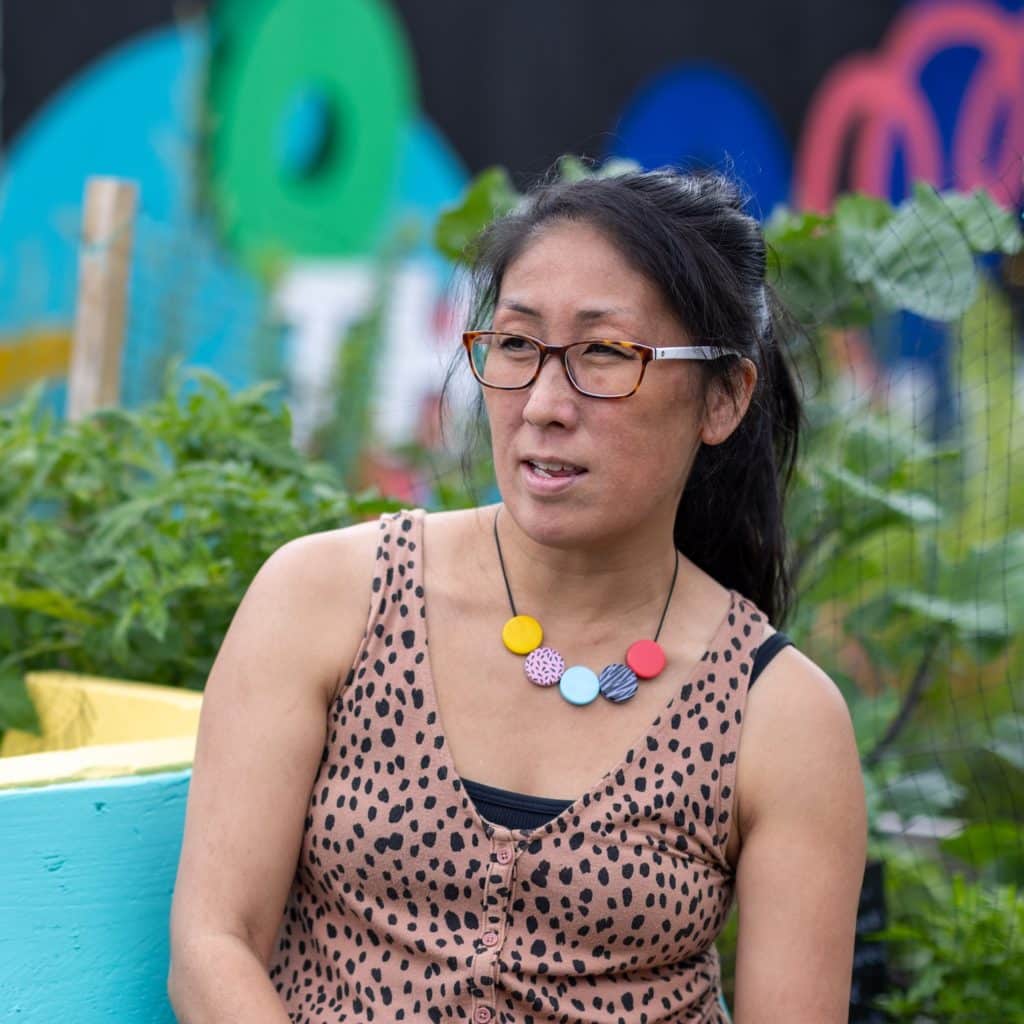
The UP Garden is the Venn overlap of these concepts. It is the biggest (900m2) of several laundry yards on a post-war council estate in Forest Gate, East London, which was also used for kickabouts and mucking about. Over time, it fell out of fashion to hang out laundry in public and the yard deteriorated through lack of maintenance, attracting drug-taking and fly-tipping. These abandoned yards create an urban heat island whilst being a constant visual reminder to the estate residents of the lack of amenity space.

The UP Garden is listed as one of DiscoverLondon‘s Spaces to Visit, which allows people to discover and investigate destinations for leisure, activities and community engagement. DiscoverLondon has multiple datasets available online for GiGL’s community to discover. We are in the process of correcting some of the details and adding more content for The UP Garden’s listing, so do keep checking back! The UP Garden is also listed on GoParksLondon, which uses GiGL datasets to highlight accessible green spaces. After a huge increase in wildlife sightings now the plants have become more established, The UP Garden is currently considering how it can contribute records to GiGL’s species database and help put wildlife on the map for Newham.
Planning and Consultation
Motivated by their grumblings on this topic and personally enraged by the approved decimation of Forest Gate’s long-standing and well-used community centre, in Summer 2021 I approached the London Borough of Newham and Swan Housing Association, who own and manage the estate respectively, about bringing the yard back into use. Together, we applied for and were awarded a GLA grant to create The UP Garden.
Just before Christmas, we created a Steering Group of stakeholders to oversee the project’s delivery (various teams at the Council, the housing association, and four local residents (including me as lead project manager), and a Working Group comprising a rolling membership of local residents who covered relevant skills and experience. We carried out in-person and online community consultations which – according to the Council – received more engagement than any Council survey in our local ward. We had spreadsheets and plans galore: Gantt project planner, budgets, layouts, plant directory…
Problems and Delays
Despite all that planning, a project of this type was bound to come up against obstacles. Logistics and actual quoted costs compared to the indicative quotes received mere months earlier meant that re-tarmacking to provide accessible pathways got crossed off the list. The initial layout was thrown in the bin after the discovery of a large infestation of Japanese Knotweed: a whole 60m2 was lost to a fenced-off contamination zone, and the original plan for semi-mature trees to provide lots of shade and raised beds to maximise the natural ground moisture had to be abandoned in favour of baby trees in flexi-tubs and planters that require ten times more water. The first grant instalment received by the Council got stuck in administrative limbo meaning the groundworks constructors started two months late and, in turn, we did not have access to the yard to start work until April 2022.
Due to so many delays, I had to substantially re-strategise the project to ensure we could still meet the funders’ deadline: this ought to have been the Working Group’s remit but, by that time, almost all of those volunteers no longer had capacity, meaning I also had to carve out additional time to undertake an urgent recruitment drive.
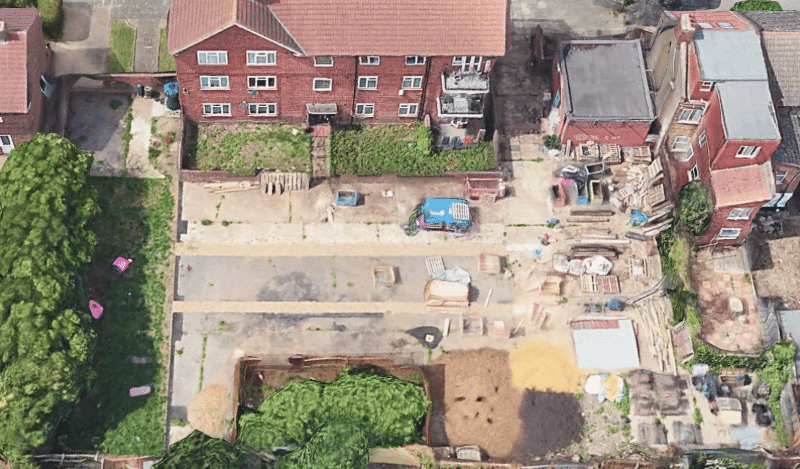
Re-strategising
However, there’s nothing better than an impossible deadline to help you focus and identify the key achievable objectives. So long, scarlet runner bean teepees. Farewell, living willow archway. Auf wiedersehen, sensory wall. And goodbye, bespoke furniture!
Instead, we did a call-out for donated furniture which we painted with our “brand” colours to provide a cohesive look, and communicate vibrancy rather than childishness. We chose a combination of planters that could be built easily and fill up the space (trellis planters to provide screening for the neighbouring housing block, long planters to create walkways, square metre-ish planters to provide micro-allotments which estate residents without gardens can apply to borrow indefinitely), or which could be upcycled quickly (tyre planters at children’s height), or which could provide instant pops of colour (large flexi-tubs for edible plants). We backtracked on creating a raised bed in one corner, instead leaving it in its natural state and turning it into a “mud lab” for open-ended play. We abandoned efforts to cut some large tree stumps to ground level, in favour of creating a raised stumpery area to attract insects and showcase shade-loving plants. And the fencing containing the Japanese Knotweed provided a perfect location for a vibrant geometric mural donated by a neighbouring artist.
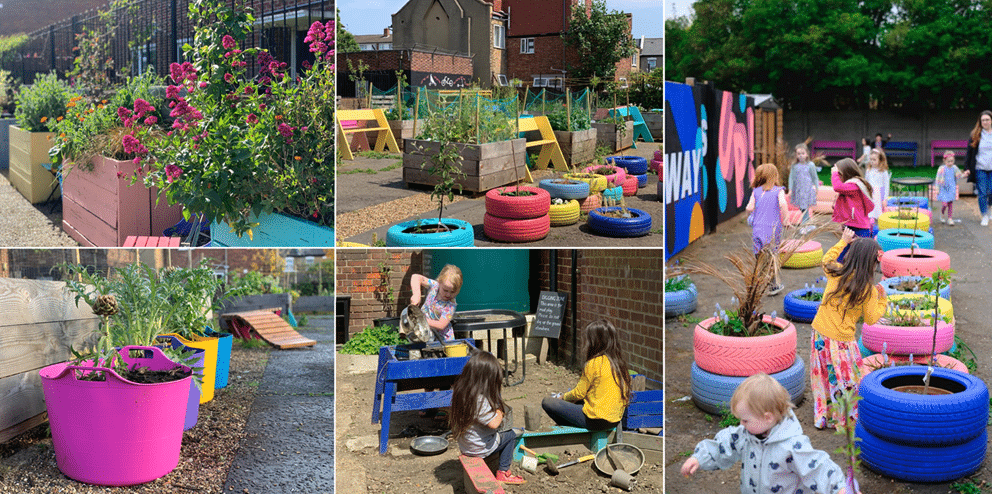
SuDS
One thing we did not compromise on was our Sustainable Drainage Systems (SuDS). We tried multiple arguments and angles to have access to a mains tap, but ultimately the answer was no. We had already persuaded the Council and Housing Association to let us tap into one of the neighbouring housing block’s downpipes to divert rainwater from its enormous roof to our huge 2000L water butt. We leveraged their rejection of mains water to gain approval to tap into further downpipes connected to six more water butts of 200L each. We expanded this plan to our pergola and shed roofs. Altogether, The UP Garden can store up to 7300L of otherwise wasted rainwater captured from 230m2 of surface area. We also have two 20m long trench drains which redirect groundwater from the asphalt surface to our play turf.
However, due to the initial delays, all of these measures had not been in place long enough by the time we were hit by a record-breaking hot Summer, reduced water pressure from a kind neighbour’s tap, and then a hosepipe ban. Until the ban, a dedicated team of local residents worked wonders to nurture the recently-laid play turf in the hope that it would survive in the long-run. The ban in August forced us to let it die as volunteer capacity was redirected to keeping other plants alive; the turf was simply too large to cover by watering cans alone.
And so we waited…
A couple of weeks before launch, we breathed a collective sigh of relief as the grass re-emerged and the first asters added dazzling pops of white and hot pink. These were a much-needed motivator for the Working Group, now in its third iteration, who had come together in a gargantuan display of community pride to toil through a scorching Summer and a rainy Autumn to deliver the final elements.
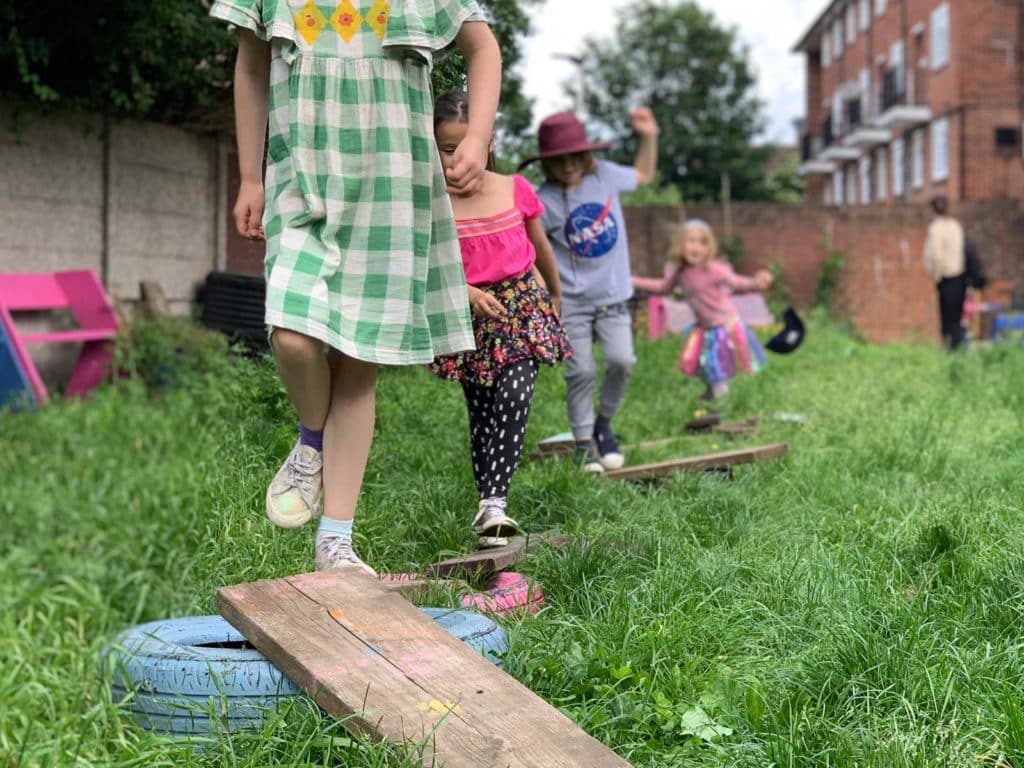
Continuing the Transformation Post-Launch
The UP Garden launched on 30 October 2022, welcoming well over 150 visitors with live music from one of our volunteers, children’s activities, and a planting session for all ages. It was thrilling to see them marvelling at the yard’s metamorphosis, at the discovery of this colourful community hub hidden within a concrete council estate, knowing it had been reclaimed for and now belonged to them.
A week later, a Committee of local residents met for the first time to take over the reins from the Steering and Working Groups. Almost all had volunteered during The UP Garden’s creation, and were keen to ensure it continued to serve the community’s needs. After agreeing a constitution and various other policies, we cracked on with strategising how to deliver features which had been bumped down the wishlist.
The first was a covered pergola, to help the community to use the yard in rainy or hot weather, and provide shelter for a fußball table which we hoped would attract teenagers (it did and does).
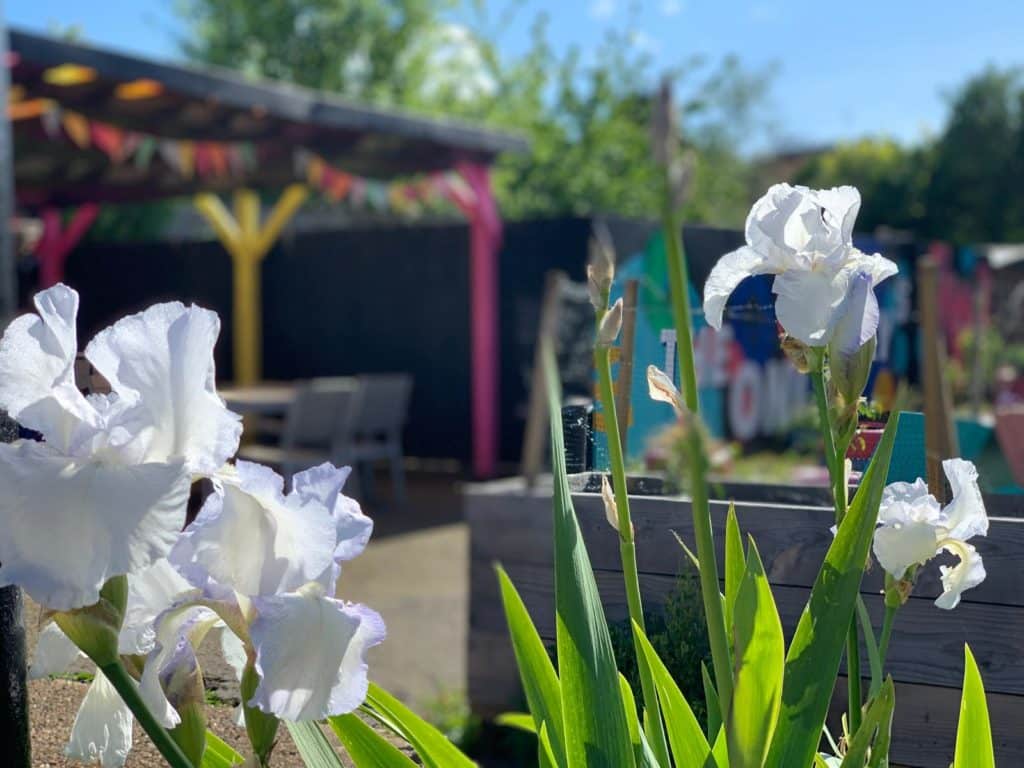
After the New Year, we added accessible planters co-designed with a wheelchair user. We also installed a buggy shelter and bicycle and scooter racks, to encourage visitors to use sustainable transport. The buggy shelter has a herb roof and drainage into a water butt. No surface is wasted!

In Spring, a particularly lumpy slab of asphalt was de-paved and replaced with a wildflower bed. This has become one of our key features, turning all of the colours of the rainbow as the greenery gets thicker in April, battling against waves of purple attacks from the lilac fiddlenecks and mauve borage and blue cornflowers throughout May. In early June, large orange-red poppies fire up, highlighted by white ox-eye daisies. Only a couple of weeks later, a yellow onslaught of corn marigolds definitively lays claim to the bed. In July, they start to lose their vibrancy along with the fiddlenecks that turn brown until we’re left with a tall straw-coloured patch of war-wounded stems. And it’s not just a visual feast: there’s a constant hum of at least a dozen bees at any moment throughout this period. They’re not put off by the flowers’ embattled state; even on the cusp of August, bees are still collecting the last scraps of pollen.
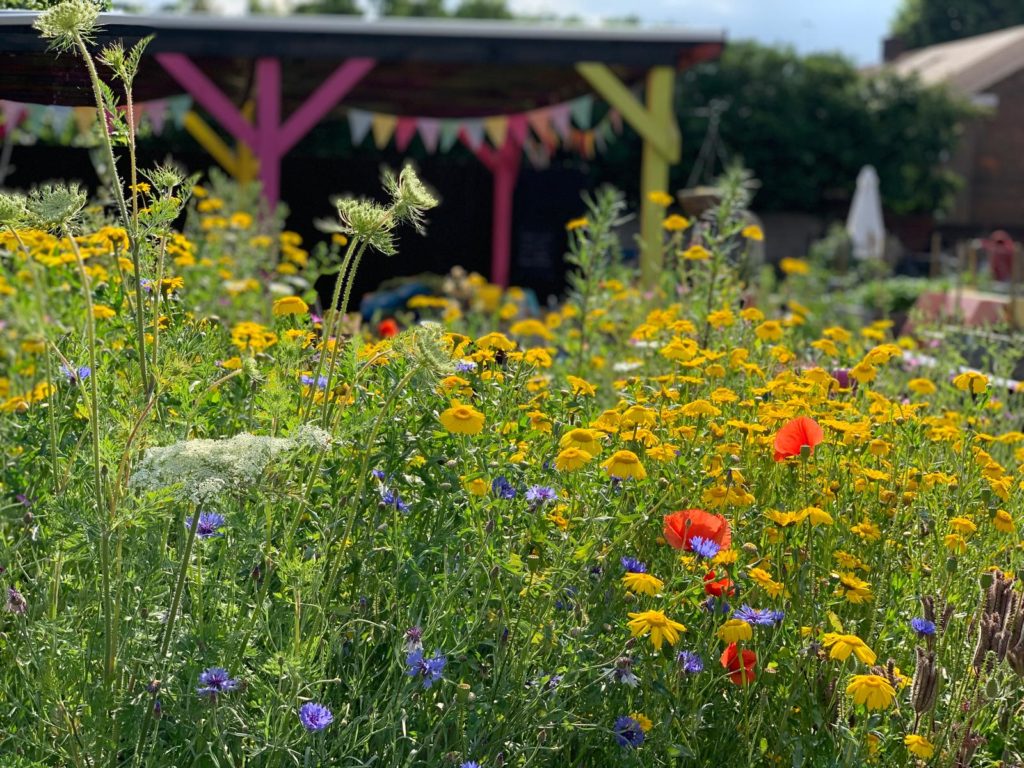
Winning the Growing Together Award
In October 2023 and a few days before the anniversary of our launch, The UP Garden was crowned the inaugural winner of The RHS’ and BBC’s Growing Together award for community gardens, featuring twice on The ONE Show. Competition judge Tayshan Hayden-Smith explained that:
“The story and the quick evolution of The UP Garden was so impressive that it just had to be recognised as the winner. A garden truly by the people, for the people. It goes to show what happens when the garden is seen as the fertile ground for change, beauty and local activism.”
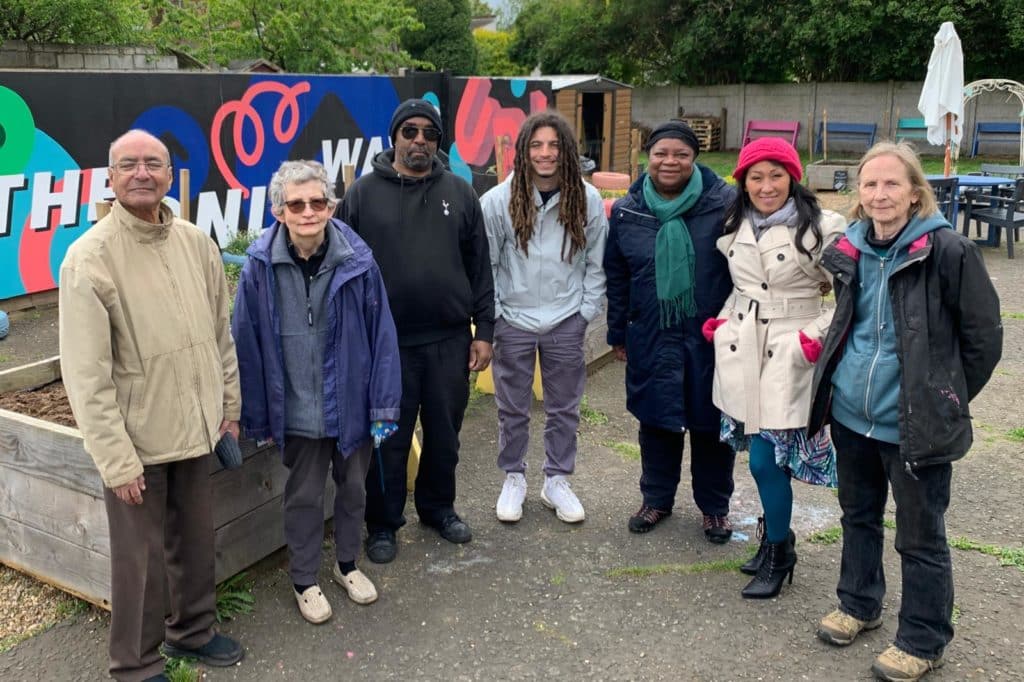
Winning an award from two such prestigious institutions really validated our approach to creating a community garden, which is that it is less about knowing about gardening, and more about knowing your community. I was and remain a terrible gardener and useless DIY-er, but I knew our community boasted a wealth of skills and knowledge. It just needed someone – with the stamina and experience of delivering projects within demanding timeframes along with a brazen “don’t ask, don’t get” attitude – to bring them all together. Hundreds of residents and businesses donated their expertise, materials, furniture, muscle… Everywhere I look, I am reminded of all the people who helped to create The UP Garden. Without them, it would have remained just a crazy idea and a bunch of spreadsheets!
Community and Connection
As well as the Committee volunteers who ensure The UP Garden continues to meet its constitutional aims, as a non-profit organisation that does not charge for entry or use of the yard or events, we rely on volunteers to help out at such events, unlock the gates every morning and lock up every evening, and keep it safe and welcoming by maintaining the plants as well as the furniture. There are about half a dozen regulars who do so, none of whom knew each other prior to The UP Garden despite living on adjacent streets for decades. For over a year, they’ve met every week for community gardening and half-time biscuits.
I think this is The UP Garden’s greatest success. Not the transformation, the sustainability, or the biodiversity that we have achieved, though I’m proud of all of them. It’s how it so easily facilitates new friendships. As well as our weekly community gardening social and quarterly community gatherings, in term-breaks we run weekly family activity sessions where we see children making instant new best friends and parents swapping details to arrange playdates. And these connections don’t just happen during our events: ours is a community hub that is open every day, all day. At any time, there might be a family taking over the “mud lab”, or a council worker stopping to have their break on a picnic bench, or a micro-allotment owner tending to their planter, or teenagers hanging out under the pergola. After a while, they start to recognise each other in The UP Garden, braving a smile or wave. They then spot each other around the estate or on the high street. We have been told about this happening, and how seeing familiar friendly faces every day significantly increases people’s feeling of safety, especially for those who might live on their own, or have no family nearby, or are new to the area.

Inspiring Others
As an unmonitored space, The UP Garden is a long-term social experiment. Whilst we have had some instances of anti-social behaviour (all very disheartening for those of us who give up our free time for the benefit of the community), they have been de minimis when considered against the number of days it has been open. This demonstrates that when councils work with communities to curate their own spaces, they feel ownership and pride and will look after those spaces. We hope that The UP Garden inspires other communities to come together to reclaim unused land to fulfil their specific needs.
